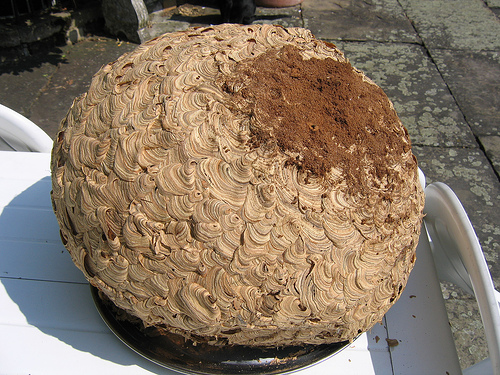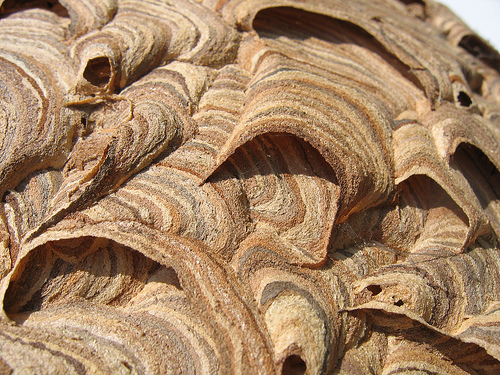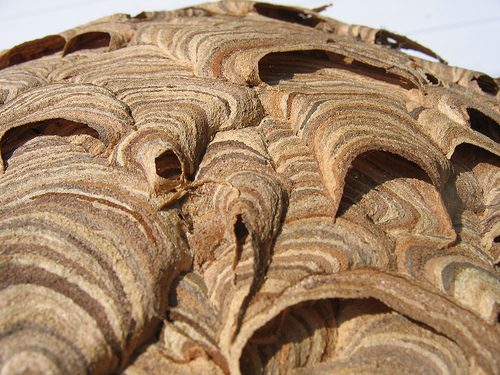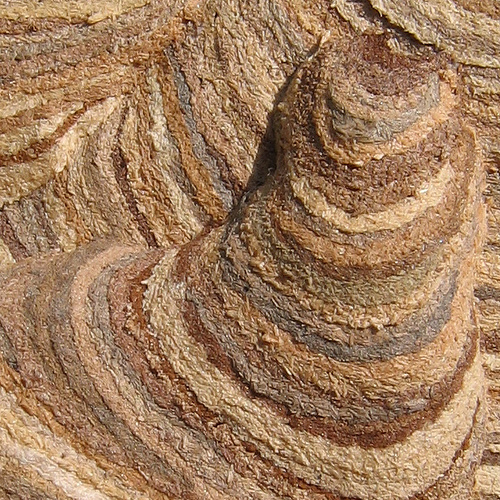Animal-made art, medicine and language








An impressive work of wasp art is discovered in an ordinary attic, lizards that use venom to lower the blood pressure of prey could contribute to new medications, researchers translate prairie dog alarms and discover a language, contestants submit ideas for bridges designed to prevent wildlife from becoming roadkill and street art in China raises awareness of wooden chopstick waste. Here are stories in ecology and the environment from the end of January 2011.
Intricate wasp nest design: Some wasps create nests by creating a paper-pulp-like material from saliva and wood fibers. The colorful nest pictured above was discovered by a plumber in an attic in the United Kingdom. Luckily for the photographer and the plumber, the wasps that created this massive nest had already abandoned their home by the time it was found. Read more or visit the original photo stream on Flickr.
Medicine from lizard venom: By surveying two dozen species of anguimorphs, researchers have found that some lizards previously thought to be nonvenomous actually are able to administer toxins. The results—published in the journal Molecular and Cellular Proteomics—provide insight into the venom delivery mechanisms of lizards. In addition, the researchers suggest the potential for developing new blood pressure medications. That is, peptides in the lizards’ venom immobilize prey by lowering its blood pressure. Read more at “Researchers take lizard venom to heart.”
Prairie dog language: A recent National Public Radio (NPR) article, describes the work of Con Slobodchikoff of Northern Arizona University, who has been studying the warning calls of prairie dogs for 30 years. Using computer programs to analyze sounds, Slobodchikoff and colleagues have found that these social rodents have more than just a couple of alarms—they seem to have an entire language. At one point, the researchers recorded prairie dog responses to four humans dressed exactly the same except for the color of their shirts. As Slobodchikoff explained in the NPR article, “Essentially they were saying, ‘Here comes the tall human in the blue,’ versus, ‘Here comes the short human in the yellow.'” Read more and hear the calls at “New Language Discovered: Prairiedogese.”
Wildlife crossing: Architects and designers submitted entries to the International Wildlife Crossing Infrastructure Design Competition to develop the most effective structure to transport wildlife across highways. The goal of the competition was to create bridges, tunnels and other paths that would encourage wildlife to safely traverse roads, thereby reducing incidents of vehicle collisions with wild animals. As described by The New York Times, the winning “bridge is broad enough to allow for strips–lanes, actually–that resemble forests, shrubs and meadows, with the aim of satisfying the tastes of any of the animals in the area. Miles of fences on either side of the highway would funnel animals to the bridge.” Read more at “Design Picked for Wildlife Crossing.”
Chopstick art: According to the Los Angeles Times, China alone disposes of nearly 130 million pairs of wooden chopsticks per day. To raise awareness of this environmental impact and encourage reusable chopsticks, the China Environmental Protection Foundation assembled a fallen tree sculpture from approximately 30,000 used chopsticks and displayed it on a city street in Shanghai. As described in the environmental design blog Inhabitat, “China’s activists estimate that the country’s current forest stock will only support chopstick production for the next 20 years.” Read more at “30,000 Used Chopsticks Transformed Into a Fallen Tree in Shanghai.”
Also, photos of a jungle growing in Vietnam caves, bacteria that could convert waste into fuel, the environmental impact of house plants, parasitic worms that turn hosts red, opinions on a Snicker’s shark commercial, corals shifting to the north, researchers track a lobster virus, climate change and threatened species, ancient bacteria preserved within salt crystals and abstinence threatens wine grapes.
Photo Credit: Harry R